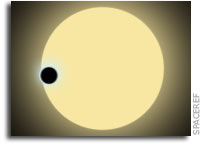Evolution of Stellar Rotation and Hydrogen Atmospheres of Habitable-zone Terrestrial Planets

Terrestrial planets formed within gaseous protoplanetary disks can accumulate significant hydrogen envelopes.
The evolution of such an atmosphere due to XUV driven evaporation depends on the activity evolution of the host star, which itself depends sensitively on its rotational evolution, and therefore on its initial rotation rate. In this letter, we derive an easily applicable method for calculating planetary atmosphere evaporation that combines models for a hydrostatic lower atmosphere and a hydrodynamic upper atmosphere. We show that the initial rotation rate of the central star is of critical importance for the evolution of planetary atmospheres and can determine if a planet keeps or loses its primordial hydrogen envelope. Our results highlight the need for a detailed treatment of stellar activity evolution when studying the evolution of planetary atmospheres.
C. P. Johnstone, M. Gdel, A. Stkl, H. Lammer, L. Tu, K. G. Kislyakova, T. Lftinger, P. Odert, N. V. Erkaev, E. A. Dorfi
(Submitted on 11 Nov 2015)
Comments: Accepted for publication in ApJ Letters
Subjects: Earth and Planetary Astrophysics (astro-ph.EP)
Cite as: arXiv:1511.03647 [astro-ph.EP] (or arXiv:1511.03647v1 [astro-ph.EP] for this version)
Submission history
From: Colin Philip Johnstone
[v1] Wed, 11 Nov 2015 20:34:11 GMT (2325kb)
http://arxiv.org/abs/1511.03647








